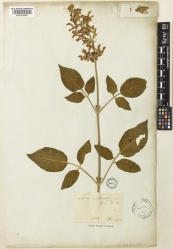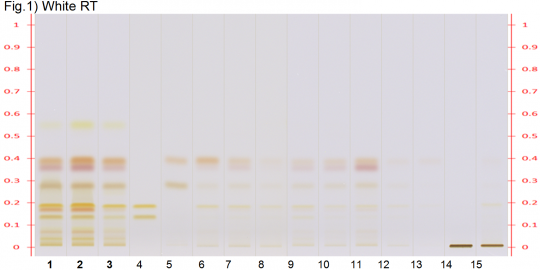Salvia miltiorrhiza (root)
Contents |
Nomenclature
Salvia miltiorrhiza Bunge Lamiaceae
Standardized common name (English): Chinese salvia
Pinyin name(s): dan shen (root & rhizome)
Botanical Voucher Specimen
 |
|
|
Organoleptic Characteristics
Macroscopic Characteristics
Microscopic Characteristics
High Performance Thin Layer Chromatographic Identification
|
Chinese Sage root, dan shen (root) (Salvia miltiorrhiza) Lane Assignments Lanes, from left to right (Track, Volume, Sample):
Reference Sample(s) Reference: Dissolve 1 mg of salvianolic acid B and 1 mg of tanshinone IIA in 1 mL of methanol. Optional: Dissolve 1 mg each of rutin and hyperoside in 1.5 mL of methanol. Stationary Phase Stationary phase, i.e. Silica gel 60, F254 Mobile Phase Toluene, dichloromethane, ethyl acetate, methanol, formic acid 4:6:8:1:4 (v/v/v/v/v) Sample Preparation Method Sample: Mix 1 g of powdered sample with 10 mL of methanol and sonicate for 10 min, then centrifuge or filter the solutions and use the supernatants/filtrates as test solutions. Derivatization reagent: Sulfuric acid reagent; Preparation: 20 mL sulfuric acid in 180 mL methanol; Use: The plate is immersed in sulfuric acid reagent for 1 s, then heated for 5 min at 100°C Detection Method Saturated chamber; developing distance 70 mm from lower edge; relative humidity 33% for optimum separation (the Rf-value of salvianolic acid B is influenced by the relative humidity) Other Notes Images presented in this entry are examples and are not intended to be used as basis for setting specifications for quality control purposes. System suitability test (UV 254 nm): Salvianolic acid: a quenching zone at Rf ~ 0.30; Tanshinone IIA: a quenching zone at Rf ~ 0.78 Identification: Compare with reference images. The fingerprint of the test solution is similar to that of the corresponding botanical reference sample. Additional weak zones may be present. Under UV 254 nm a prominent quenching zone corresponding to salvianolic acid B is detected at Rf ~ 0.30 in all samples. After derivatization this zone appears reddish under white light (red arrows). Above the zone due to salvianolic acid there is a quenching zone at Rf ~0.51 (grey under white light) and possibly a weak quenching zone at Rf ~ 0.40. At the position of reference tanshinone IIA there is a prominent quenching zone which appears reddish under white light. Just below it there is another quenching zone which appears yellow under white light. For detailed analysis of tanshinones and other apolar compounds method Chinese Sage root (tanshinones) can be used. Source: HPTLC Association [2] |
|
Chinese Sage, dan shen Tanshinones (root) (Salvia miltiorrhiza) Lane Assignments Lanes, from left to right (Track, Volume, Sample):
Reference Sample(s) Reference: Dissolve 0.6 mg each of tanshinone I, tanshinone IIA, cryptotanshinone, and dihydrotanshinone in 1.5 mL of ethyl acetate. Stationary Phase Stationary phase, i.e. Silica gel 60, F254 caffeine impregnated (preparation: immerse plate into a solution of 80 g/L caffeine in dichloromethane for 1 s, dry at room temperature for 5 min, then at 80°C for 5 min). Mobile Phase Toluene, ethyl acetate, acetic acid 95:5:1 (v/v/v) Sample Preparation Method Sample: Mix 1 g of powdered sample with 10 mL of ethyl acetate and sonicate for 10 minutes, then centrifuge or filter the solutions and use the supernatants / filtrates as test solutions. Derivatization reagent: Sulfuric acid reagent; Preparation: 20 mL sulfuric acid in 180 mL methanol; Use: The plate is immersed in sulfuric acid reagent for 1 s, then heated for 5 min at 100°C Detection Method Saturated chamber; developing distance 70 mm from lower edge; relative humidity 33% Other Notes Images presented in this entry are examples and are not intended to be used as basis for setting specifications for quality control purposes. System suitability test: Tanshinone I: brownish zone at Rf ~ 0.27 (derivatized, white RT); Tanshinone IIA: violet zone at Rf ~ 0.39 (derivatized, white RT); Dihydrotanshinone: yellow zone at Rf ~ 0.13 (derivatized, white RT); Cryptotanshinone: reddish zone at Rf ~ 0.18 (derivatized, white RT). Identification: Compare results with reference images. The fingerprint of the test solution is similar to that of the corresponding botanical reference sample. Additional weak zones may be present. Under white light the chromatogram of the test solution shows distinct yellow to orange zones corresponding to reference substances dihydrotanshinone, cryptotanshinone, tanshinone I, and tanshinone IIA. Just below the position of cryptotanshinone there is another distinct yellow zone. Just below the position of tanshinone IIA a purple zone is seen. Additional yellow zones are detected between reference dihydrotanshinone and the start position. After derivatization under white light the chromatogram of the test solution shows a yellow zone corresponding to reference dihydrotanshinone, an orange zone corresponding to reference cryptotanshinone, a greenish zone corresponding to reference tanshinone I and a purple zone corresponding to reference tanshinone IIA. Just below the position of cryptotanshinone there is a distinct violet zone. Just below the position of tanshinone IIA a bluish violet zone is seen. Weak grey zones are detected between reference dihydrotanshinone and the start position. Source: HPTLC Association [3] |
Supplementary Information
Sources
- ↑ Royal Botanic Gardens, Kew. http://specimens.kew.org/herbarium/K000929863
- ↑ HPTLC Association http://www.hptlc-association.org/
- ↑ HPTLC Association http://www.hptlc-association.org/






